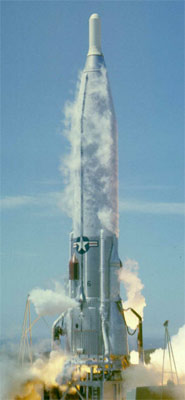 Launch of an Atlas-F missile | |
| Function | ICBM Expendable launch system |
|---|---|
| Manufacturer | Convair |
| Country of origin | United States |
| Launch history | |
| Status | Retired |
| Launch sites | LC-11 & 13 CCAFS OSTF-2, LC-576 & SLC-3, VAFB |
| Total launches | 70 |
| Success(es) | 53 |
| Failure(s) | 17 |
| First flight | 8 August 1961 |
| Last flight | 23 June 1981 |
| Boosters | |
| No. boosters | 1 |
| Powered by | 2 LR-89-5 |
| Total thrust | 369,802 lbf (1,644.96 kN) |
| Specific impulse | 256 s |
| Burn time | 120 s |
| Propellant | RP-1/LOX |
| First stage | |
| Powered by | 1 LR-105-5 |
| Maximum thrust | 86,844 lbf (386.30 kN) |
| Specific impulse | 316 s |
| Burn time | 309 s |
| Propellant | RP-1/LOX |
The SM-65F Atlas, or Atlas-F, was the final operational variant of the Atlas missile, only differing from the Atlas E in the launch facility and guidance package used. It first flew on 8 August 1961,[1] and was deployed as an operational ICBM between 1961 and 1966. Following retirement as an ICBM, the Atlas-F, along with the Atlas-E, was refurbished for orbital launches as the Atlas E/F.[2]
The Atlas E and F also differed in their launch facilities; Atlas E utilized the same coffin silos as Atlas D missiles, with the missile stored horizontally and raised upright for launch. Atlas F for comparison used a vertical silo with an elevator similar to the Titan I. The Atlas F was originally conceived when the Air Force decided that the coffin silos used for the Atlas D and E were too exposed and vulnerable to enemy attack.
Atlas E and F used the MA-3 propulsion system which had a separate gas generator for all three engines, unlike the Atlas D where one gas generator drove both booster turbopumps. In addition, they used pyrotechnic cartridges for rapid starting and the gas generators and pumps were mounted on each booster engine instead of being placed in the central thrust section. This setup was designed for ease of service and engine swapping in the field, while the Atlas D's simpler configuration was considered preferable for space launches. Total thrust of the MA-3 was 375,000 pounds-force (1,670 kN).
Atlas E/F used the ARMA inertial guidance system rather than Atlas D's radio ground guidance; some IOC (Initial Operational Capability) Atlas D flights tested the ARMA system instead of the standard GE Mod II radio guidance. Aside from minor differences in the ARMA on the Atlas E and F, the major difference between the two consisted of differently-placed quick fill lines for the two silo systems used.
Most refurbished Atlas F space launches used solid-fueled upper stages, a notable exception being Missile 23F which launched Seasat, a NASA oceanography satellite, on June 27, 1978, the last Atlas-Agena vehicle flown. The final Atlas F launch took place on June 23, 1981 when Missile 87F successfully placed a NOAA weather satellite into orbit. Atlas E/F space launchers were given an extensive tear-down and rebuild by Convair and the ARMA system replaced with the GE Mod II guidance system.
- ^ "Atlas-F (SM-65F / HGM-16F) ICBM". Gunter's Space Page. Retrieved 2024-03-30.
- ^ Encyclopedia Astronautica - Atlas